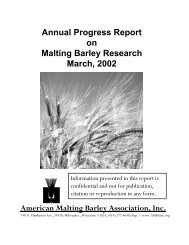Annual Progress Report on Malting Barley Research March, 2007
Annual Progress Report on Malting Barley Research March, 2007
Annual Progress Report on Malting Barley Research March, 2007
You also want an ePaper? Increase the reach of your titles
YUMPU automatically turns print PDFs into web optimized ePapers that Google loves.
western Minnesota is c<strong>on</strong>sistent with that of a sexually reproducing fungus. This diversity<br />
and likelihood of a sexual stage in S passerinii indicate that single dominant resistance<br />
genes may have a limited life if employed widespread throughout the regi<strong>on</strong>. C<strong>on</strong>siderati<strong>on</strong><br />
should be given to pyramiding more than <strong>on</strong>e of the genes into breeding material.<br />
7. C<strong>on</strong>trol of FHB in <strong>Barley</strong> by reducing inoculum load of the pathogen. PhD Student<br />
Scott Halley tested in the field at Langd<strong>on</strong> in 2006, 15 chemical treatments plus an<br />
untreated c<strong>on</strong>trol <strong>on</strong> Fusarium infested crop stubble for their ability to inhibit pathogen<br />
sporulati<strong>on</strong> and head blight disease. Sporulati<strong>on</strong> was measured by bagging and exposing<br />
barley heads for predetermined times and then washing and culturing to determine the<br />
number of spores <strong>on</strong> the heads. Sporulati<strong>on</strong> was also measured by placing volumetric<br />
spore collectors and open Petri plates with selective isolati<strong>on</strong> media under the barley<br />
canopy. Due to the dry seas<strong>on</strong> little infecti<strong>on</strong> was seen and few spores were measured.<br />
Experiments will have to be repeated in 2006 to obtain useful data.<br />
In a sec<strong>on</strong>d study undertaken with Mr. Halley, we investigated the effect of fungicide<br />
applicati<strong>on</strong> at different stages of tiller development in an attempt to explain the poor c<strong>on</strong>trol<br />
of FHB fungicides sprayed <strong>on</strong> barley compared to the c<strong>on</strong>trol obtained <strong>on</strong> wheat. Tillers<br />
that were spayed with fungicide at maturities earlier or later than that recommended<br />
suggests that two-rowed and six-rowed barleys as well as hard red spring wheat may<br />
benefit from additi<strong>on</strong>al fungicide applicati<strong>on</strong>s to protect these tillers in some envir<strong>on</strong>ments.<br />
An applicati<strong>on</strong> of tebuc<strong>on</strong>azole fungicide <strong>on</strong>ly reduced FHB incidence at head fully<br />
emerged growth stage but did not affect tillers that had not reached this growth stage. As<br />
barley does not develop synchr<strong>on</strong>ously there is always a proporti<strong>on</strong> of tillers at spraying<br />
that are younger and older than the recommended age Deoxynivalenol c<strong>on</strong>centrati<strong>on</strong>s<br />
were reduced in <strong>on</strong>e envir<strong>on</strong>ment when the growth stages were head partially emerged<br />
and head fully emerged but were not reduced by other growth stages.<br />
Experiments are also c<strong>on</strong>tinuing with Prof Nick Hill at the University of Georgia. We have<br />
collected, purified and shipped several shipments of spores to Prof Hill to determine the<br />
specificity of his ELISA method of Fusarium graminearum quantificati<strong>on</strong>s, the minimum<br />
detecti<strong>on</strong> limits and the impact of method of shipment <strong>on</strong> sensitivity. All experiments are<br />
<strong>on</strong>going.<br />
OTHER FUNDS AND FUTURE DIRECTIONS<br />
1. Comm<strong>on</strong> Root Rot Resistance Gene Mapping for <strong>Barley</strong> CAP<br />
<strong>Research</strong> in 2006 was the first year of a four year project funded by the CSREES CAP<br />
<strong>Barley</strong> project. Comm<strong>on</strong> root rot (CRR) caused by Bipolaris sorokiniana has been<br />
identified as a disease of importance in barley in North Dakota and in adjacent Canadian<br />
Provinces. Losses in yield average 5 to 15% and are more c<strong>on</strong>sistent than leaf diseases<br />
that occur in epidemics. Canadian researchers have been breeding for resistance to CRR<br />
and Canadian Pathologists have been supplying informati<strong>on</strong> to growers for more than 40<br />
years so that they can manage the disease and use resistant cultivars. No informati<strong>on</strong> or<br />
resistant lines are available in North Dakota.<br />
We organized and took receipt of the subset of OPAH2 lines available in sufficient<br />
quantities (about 500g) for large scale field trials for testing of disease reacti<strong>on</strong> to comm<strong>on</strong><br />
68
















